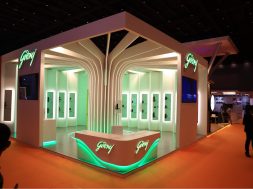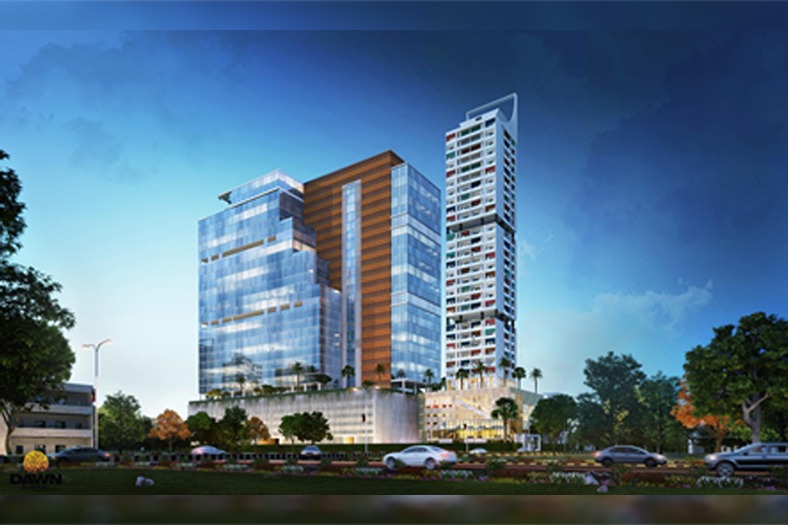Technology trends for high-rise

An analysis on the key trends that are evolving the high-rise building space.
High-rise buildings are an integral part of modern urban environments. The key factor for planning a high rise is manufacturing and flexibility. Tall buildings are the leading symbols of the skylines of big cities and are turning out to be ever more man-made marvels.
With every passing decade, the height of buildings has been increasing profusely; technological progresses are being integrated into building constructions and factors such as wind, gravity and earthquake resistance are being given superior value. The technologies play a vital role in high-rise building in form of construction chemicals, paints, concrete, steel, admixtures, waterproofing, epoxy coating and many more.
Trends in concrete industry
With rapid urbanisation becoming a necessity to accommodate and capture exponential growth in demand for commercial and residential space in fast growing cities, the construction industry is poised for a boom in the vertical direction. Atul Desai, Executive Director and CEO, RMC Readymix (India) [A division of Prism cement Limited] says, “The accelerated growth in metro projects to ease commutation of masses can happen only on vertical horizon. Redevelopment of residential building is becoming a common phenomenon to establish higher safety standards such as fire resistance and accommodating more household in existing floor space.”
Atul informs, “High strength concrete is one of the prominent solutions which reduce cross sectional area of structural component like columns and thereby, increasing floor space for purposeful use.”
RMC Readymix (India) has one such innovative concrete solution- Megacrete (It is a high strength concrete with specified strength of 65 MPa and above). Megacrete can reduce concrete column size by 45 per cent for M100 as compared to M40 concrete thereby resulting in further cost saving of structural steel due to reduction in its consumption. As a result, more useable area is available either for car parking (basement and ground floor) or designing the interior to higher capacity.
Concrete is an essential and main component of any construction. Ibrahim Shaikh, Sr. Product Manager, Sika India Pvt Ltd explains the main challenges in concreting at great heights as:
• High performance concrete (HPC)
• Conveying (Pumping) concrete to the required height
• Workability (Flowability) over time.
High performance concrete (HPC): The strength of the high performance concrete ranges from 50 Mpa– 100 Mpa.
Requirement of HPC
• Very low water and Cement ratio generally
less than 0.3
• Considerably high cement content
• Part of cement is replaced by cementitious materials
• Use of High efficient Superplasticizers.
Challenges for making high performance concrete:
• Variations in fine and coarse aggregates
• Different source of cement with varying mineralogy
• Different cementitious materials properties
• Varying climatic conditions.
A robust Superplasticizers is the solution to the above challenges – Sika ViscoCrete technology
Conveying or pumping the concrete to the desired height
Because of very low water and cement ratio and high fines content the concrete becomes very sticky, viscous and difficult to pump.
Ibrahim informs, “Sika ViscoCrete technology helps in reducing the viscosity, yield stress, giving better fresh concrete behaviour even at such a low water and binder ratio so that concrete can be pumped easily to the required height.”
Workability over time
“To bring the concrete from long distances or site batched concrete. The concrete should have minimum flow retention period of 2-3 hours for pumping and finishing and it should set normally,” says Ibrahim.
“Sika ViscoCrete technology retention polymers helps in retaining (workability) flowability for hours without any effect on the setting time of the concrete,” he adds.
Trends in concrete admixtures industry
“Concrete admixtures have emerged as one of the most valued component of concrete for high rise RCC structures. It is these admixtures that when dosed with concrete bring out the inherent abilities of the various constituents of concrete and allow the designer to truly take advantage of the concrete’s entire range of properties as a material of construction,” Informs, Ishita Manjrekar, Director, Sunanda Speciality Coatings Pvt Ltd.
Super plasticising admixtures and admixtures for self consolidating, high performance concrete is fast becoming the order of the day.
Further, various value added admixtures such as durability enhancing corrosion inhibiting admixtures, crystalline waterproofing admixtures, shrinkage compensating admixtures, air entraining admixtures etc, are finding increasing applications in modern high rises.
Ishita adds, “These are extremely positive trends and demonstrates that these new material technologies are the need of the hour and the knowledge and will to utilise global best practices is gradually percolating throughout the construction industry in India.”
Trends in construction chemical industry
Swapnil R. Deshmukh, Sr.Marketing Manager, Chembond Chemicals Limited says, “As India moves higher on the industrialisation and prosperity curve, the growth in the construction industry would be assured. More manufacturing activity would lead to more jobs, which would lead to higher demand for housing which would result in the growth of towns and cities, which ultimately will mandate infrastructure development. All around construction growth is assured.”
Moreover Swapnil opines, “How fast these are acted upon by the government departments is unknown. Private investment led construction activity is however poised for a healthy growth of about 7-8 per cent Y-o-Y for the next few years. The market for higher performance products would grow. As not all products have been used in India, we expect to see a growth in demand for ‘special’ products that have not been common in the Indian market place.”
Some construction technologies like Insulation in buildings make commercial sense in temperate countries like India but have not been widely used till date due to lack of experience or demand. With international investments in construction, the construction practices would also undergo a change and see an increase in demand for new products.
Indian cities have seen a great surge in population increase and migration, this continued growth in population and need for housing and work, has pushed the developers to build vertically. Once a rarely seen phenomenon, reserved mainly for the urban areas of the country, high-rises have become common site in tier-two cities and mini-metros.
Anandita Kakkar, Deputy General Manager, Kryton Buildmat Co. Pvt Ltd says, “For these tall buildings, an essential need is waterproofing as they have a two prong waterproofing dilemma, the basement has a huge load and needs to be dry and durable. Also, the top floors face a strong wind – rain factor, where the rain does not just fall straight but also sideways due to the heavy winds. This requires the walls and roof to be impermeable. For this a solution has add durability, save time and be cost effective.”
Anandita informs, “The Krystol technology is a boon to tall buildings given its simplicity of use and effectiveness in waterproofing the entire structure, because it replaces the unreliable exterior membranes, liners and coatings is impervious to physical damage and deterioration, provides excellent resistance to waterborne chemicals such as sulfates, chlorides, and acids and reduces concrete shrinkage and cracking.”
The Krystol technology is available in the form of admixture, grout and coating. This makes it easier to choose the right solution depending on the site’s needs. Krystol technology is unique in terms of not just its chemical properties, but also physical properties. This technology uses water as a catalyst to create long, narrow crystals within the concrete itself. These crystals permanently fill the pores, capillaries and hairline cracks of the concrete mass, and continue to grow throughout the concrete, reaching lengths of many inches over time.
Anandita believes that, once the concrete has cured, the crystalline chemicals sit dormant until another dose of water (such as through a new crack) causes the chemical reaction to begin again. The ability to reactivate in the presence of water gives Krystol-treated concrete the ability to ‘self-seal’. When cracks form due to curing shrinkage, settling, seismic activity, etc., water entering through them causes new crystals to form and grow, blocking and filling the cracks.
Sunny Surlaker, Head – Admixture Division, MC-Bauchemie says, “The construction of tall buildings is becoming more and more common as the available land bank shrinks and the expansion needs to be solely vertical. Concrete is the material of choice today owing to the mould ability, economy, speed and durability aspects it provides to the structures. Handling concrete is as much of a skill as it is a science. In terms of concrete, engineers bring together over 2500 kg of varied raw materials (binders, aggregates, sand, water and additives) per cubic meter, to cast a homogenous material that is expected to last in excess of 50 to 100 years.”
He adds, “Bringing homogeneity and imparting durability to a combination of these materials is the task of construction additives, which fall under the category of construction chemicals. As we see it, concrete construction without of the use of construction chemicals, is not possible today.”
Sunny shares the concept of tall structures, construction chemicals can help to enhance the following areas:
• Durability enhancement for the structure
• Load reduction in the superstructure
• Minimising operational maintenance
• Fast finishing systems
• Aesthetics
• Speed of construction.
Sunny believes that the construction of these buildings entails special technologies in terms of specialised formwork, pumpable concrete, automated finishing and vertical transportation facilities. Due to the height and nature of these buildings, it is quite difficult to attend to their repair and maintenance needs on a frequent basis. MC-Bauchemie needs to ensure, that the production, transportation, placing, finishing and curing requirements of the concrete and other materials are paid special attention to. The need for these structures will include:
• Materials pumpable to great heights, easily transportable
• Curing systems for the elements (slender elements with high performance concrete)
• Waterproofing systems that behave as one with the structure and need minimum intervention and re-work
• Specialist protective systems for floors and walls of the building to provide durability to the structure as a whole.
Sunny informs, “To aid in achieving these needs, construction chemicals like concrete additives (plasticizers, superplasticizers, integral water-proofers, polymer dispersions, etc.) were designed and introduced. All in all durability can be achieved by improving the quality of concrete as well as protecting concrete from deterioration mechanism due to chemical, physical, thermal and environmental attacks. We look at durability as providing both sustainability and affordability (reduced maintenance and repair costs) over the life of the structure.”
High strength concrete is one of the prominent solutions which reduce cross sectional area of structural components
Atul Desai, Executive Director & CEO, RMC Readymix (India) [A division of Prism cement Limited]
Concrete is an essential and main component of any construction.
Ibrahim Shaikh, Sr. Product Manager, Sika India Pvt Ltd
Concrete admixtures have emerged as one of the most valued component of concrete for high rise RCC structures.
Ishita Manjrekar, Director,
Sunanda Speciality Coatings Pvt Ltd
As India moves higher on the industrialisation and prosperity curve, the growth in the construction industry would be assured.
Swapnil R. Deshmukh, Sr.Marketing Manager, Chembond Chemicals Limited
The Krystol technology is a boon to tall buildings given its simplicity of use and effectiveness in waterproofing the entire structure.
Anandita Kakkar, Deputy General Manager, Kryton Buildmat Co. Pvt Ltd
The construction of tall buildings is becoming more and more common as the available land bank shrinks and the expansion needs to be solely vertical.
Sunny Surlaker, Head – Admixture Division, MC-Bauchemie
31
Cookie Consent
We use cookies to personalize your experience. By continuing to visit this website you agree to our Terms & Conditions, Privacy Policy and Cookie Policy.









